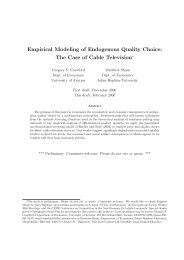Forward-Looking Bidding in Online Auctions. - The University of ...
Forward-Looking Bidding in Online Auctions. - The University of ...
Forward-Looking Bidding in Online Auctions. - The University of ...
- No tags were found...
You also want an ePaper? Increase the reach of your titles
YUMPU automatically turns print PDFs into web optimized ePapers that Google loves.
game. F<strong>in</strong>ally, it is notable that bidders only submit positive bids on products <strong>of</strong> their desiredtype – a result that will lead to identification <strong>of</strong> personal preferences <strong>in</strong> the empirical test.<strong>The</strong> bidd<strong>in</strong>g function is fully characterized by the expected surplus function S, which is <strong>in</strong>turn characterized by the steady-state distribution <strong>of</strong> the future competition c 1 conditional on thecurrent competition c 0 and all the state variables <strong>in</strong>volved <strong>in</strong> the relationship between them:( | , , , , , )G c c ϕ ϕ ϕ ω ω . In equilibrium, the surplus function must reflect the actual expected1 0 0 1 2 1 2surplus given that everyone uses the optimal bidd<strong>in</strong>g strategy (2). <strong>The</strong>refore, the equilibriumexpected surplus function must satisfy the Bellman equation (3). Such an S function existsbecause <strong>of</strong> the cont<strong>in</strong>uity <strong>of</strong> f, compactness <strong>of</strong> its support, and the fact (shown <strong>in</strong> the pro<strong>of</strong> <strong>of</strong>Proposition 1) that the slope <strong>of</strong> S <strong>in</strong> any <strong>of</strong> its arguments is uniformly bounded. However,equilibrium S cannot be expressed <strong>in</strong> closed form even for a simple distribution F and small N.Despite the lack <strong>of</strong> a closed-form solution, some general comparative statics <strong>of</strong> the bidd<strong>in</strong>gfunction can be derived from an analysis <strong>of</strong> the Bellman equation (see Appendix for a pro<strong>of</strong>):Proposition 2: For all F, the equilibriumb( ϕ , ϕ , ω , v)0 1 1has the follow<strong>in</strong>g properties:( )1) b 1, ϕ , ω , v <strong>in</strong>creases <strong>in</strong> ω2)1 1( ) ( )1( )b 0, ϕ , ω , v = 0< b 1,1, ω , v < b 1,0, ω , v < v for all v>0.1 1 1 1( )3) b 1, ϕ , ω , v decreases <strong>in</strong> ρ1 1<strong>The</strong> first property shows that bids decrease when the future gets closer <strong>in</strong> the sense that ω 1decreases. In the empirical section, a generalization <strong>of</strong> this result will be tested, namely theprediction that bids decrease as the number <strong>of</strong> auctions <strong>in</strong> the next hour <strong>in</strong>creases. <strong>The</strong> secondproperty conta<strong>in</strong>s several important results. <strong>The</strong> first <strong>in</strong>equality shows that all bidders withpositive valuations submit positive bids on objects. This both guarantees trade and allows an13
















